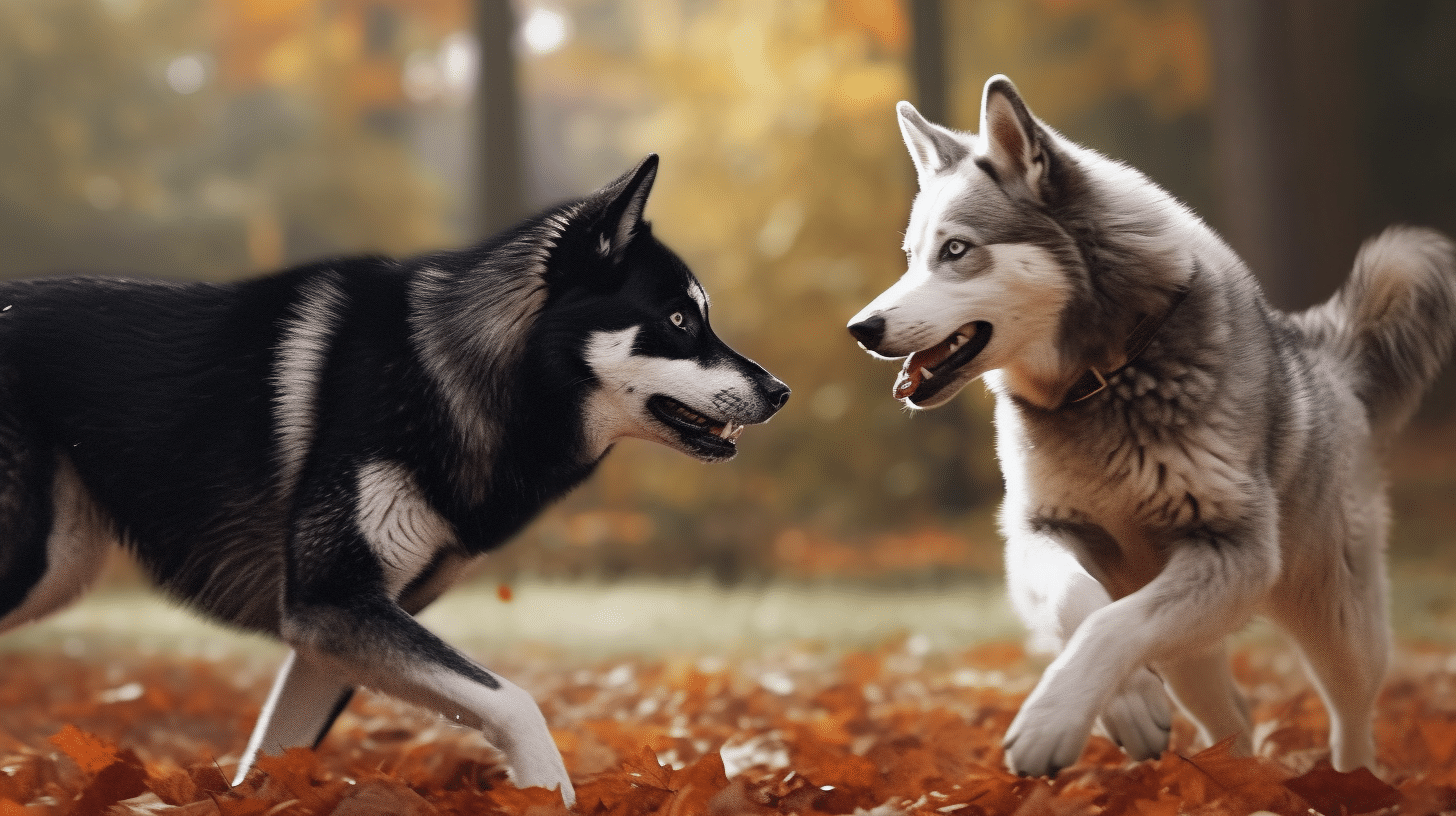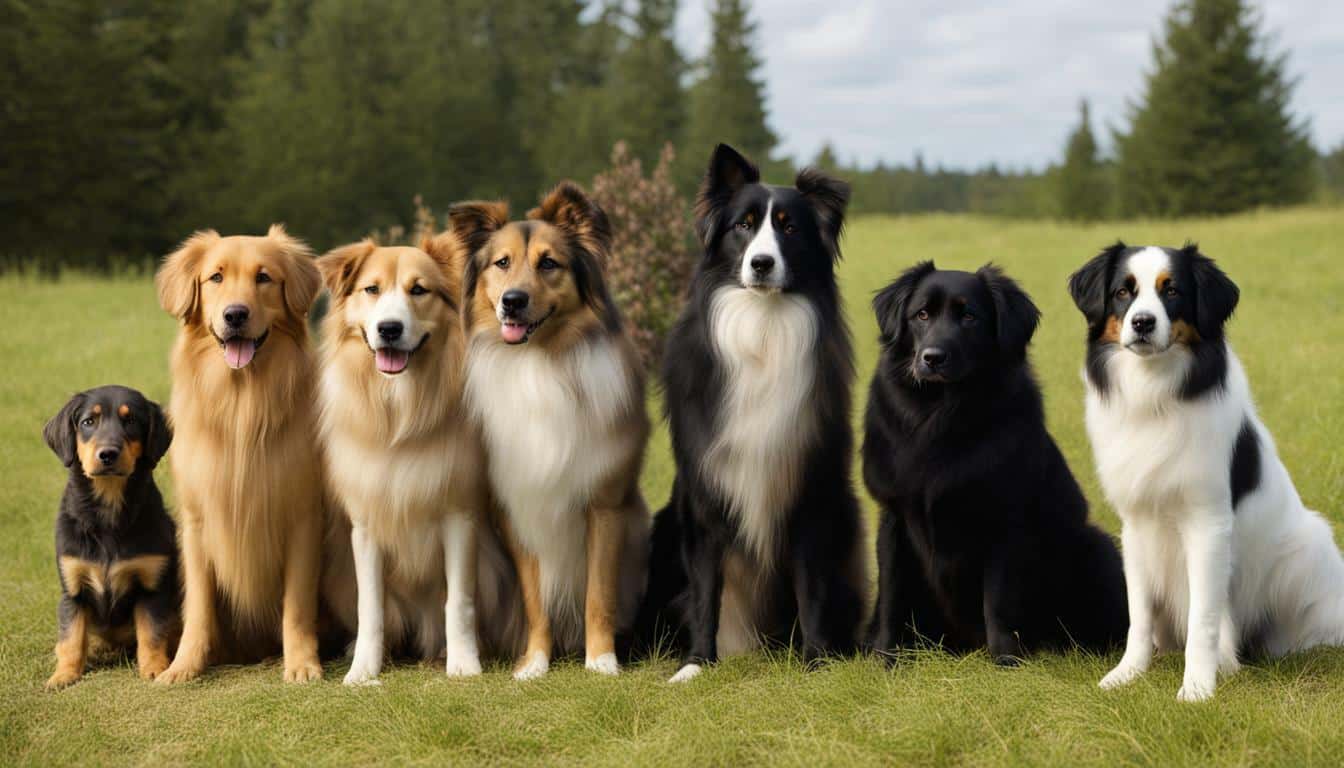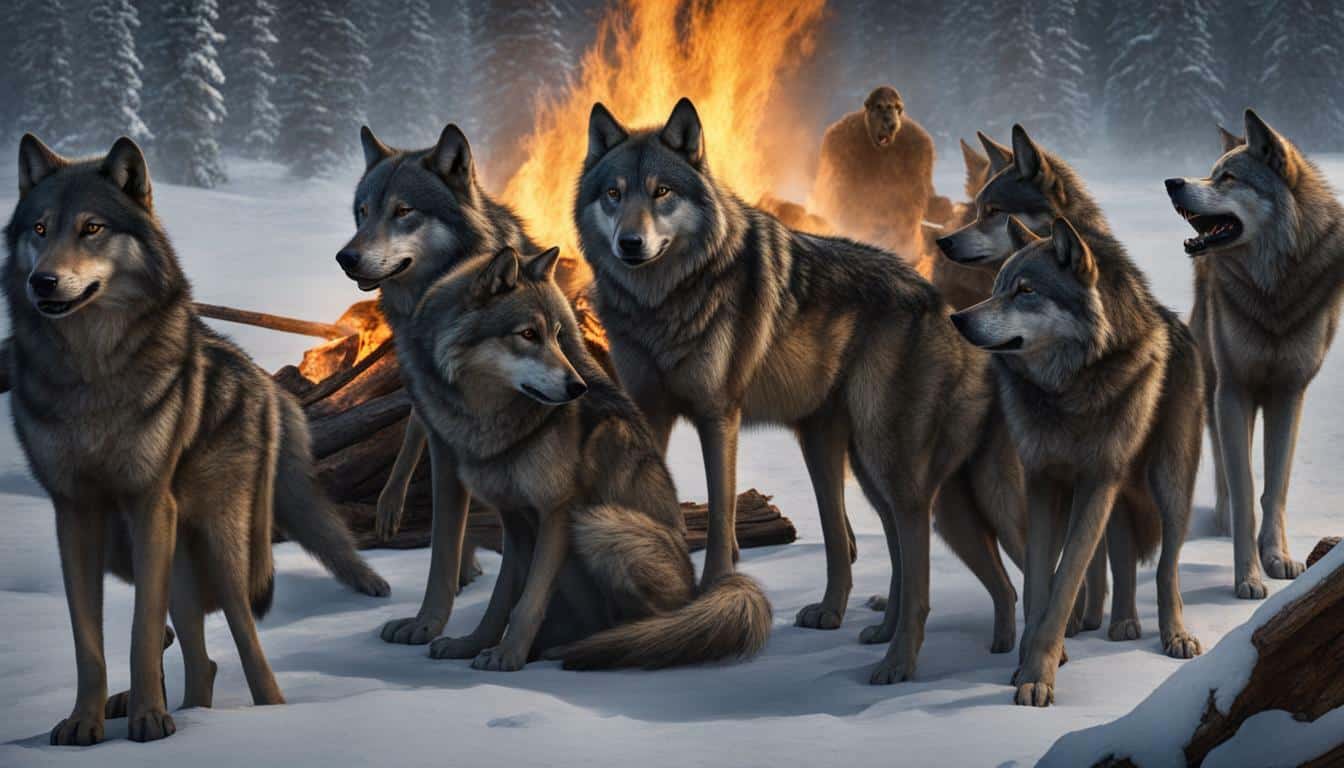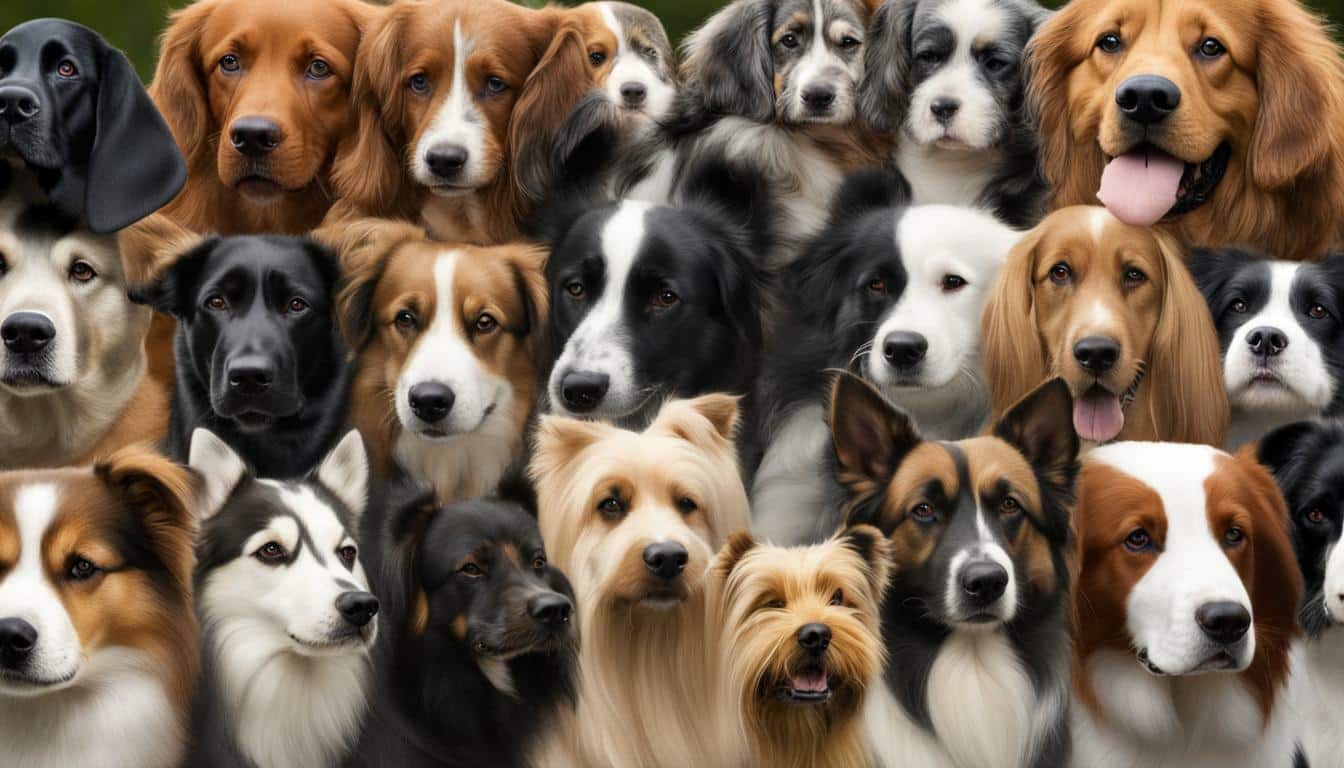The Evolution and Origins of Dog Domestication

Dogs have been man’s best friend for thousands of years, but have you ever wondered how they came to be domesticated? The history of dog domestication is a fascinating tale of evolution, selective breeding and the bond between humans and animals.
The origins of dog domestication date back to the time when humans and wolves first interacted. Some theories suggest that wolves were attracted to the scraps of food that humans left behind and began to hang around human settlements. Over time, these wolves evolved to become more comfortable around humans, which eventually led to the domestication of dogs.
The process of domestication involved selective breeding, whereby early humans bred dogs for specific purposes such as hunting, herding and guarding. This selective breeding led to the emergence of different dog breeds, each with their own unique characteristics.
Genetic variation also played a crucial role in the evolution of dogs from their wolf ancestors. Over time, dogs developed physical and behavioral traits that made them better suited to living alongside humans.
The strong bond between humans and dogs has been a driving force in the domestication process. Dogs have become an integral part of human society, serving as working companions, loyal family pets and even therapy animals. The evolution and origins of dog domestication are a testament to the deep connection between humans and animals.
Stay tuned to discover more about the fascinating world of dog domestication, including the impact of modern breeding practices, the cultural significance of dogs and the scientific advancements that have shed light on the evolution of our beloved canine companions.
The Early Primal Connection
The relationship between humans and dogs is believed to have begun over 15,000 years ago during the late Stone Age. Although the exact circumstances that led to the domestication of dogs are still debated, it is widely accepted that early humans developed a primal connection with wolves that eventually evolved into the human-canine bond we know today.
It is hypothesized that wolves began scavenging human garbage and became accustomed to the presence of humans. As a result, the wolves started to approach humans more frequently, and over time, humans began to tame and train them for specific tasks such as hunting, guarding, and companionship.
As dogs evolved from their wolf ancestors, they became better adapted to living near humans and developed a unique set of physical and behavioral traits. Genetic variation played a significant role in this evolution, allowing dogs to develop specialized skills that were beneficial to humans.
Today, the human-canine bond is stronger than ever, with dogs serving as loyal companions and working partners in a wide variety of fields. Whether as a family pet, search and rescue dog, or therapy animal, the bond between humans and dogs continues to thrive.

One of the most significant factors in the domestication of dogs was the process of selective breeding. Early humans selectively bred dogs for specific traits, such as hunting, herding, or companionship, leading to the emergence of different breeds with distinct physical and behavioral characteristics.
Through selective breeding, humans have been able to shape the evolution of dogs, resulting in the diverse range of breeds we see today. This process has allowed for the development of dogs that excel in specific tasks and roles, such as the Border Collie, a breed known for its exceptional herding abilities.
The importance of the human-animal bond cannot be overstated in the process of selective breeding. As humans developed closer relationships with dogs, they were able to carefully select and breed dogs that exhibited traits desirable for specific tasks or roles. This bond allowed humans to understand the natural behaviors and tendencies of dogs and use this knowledge to selectively breed for specific characteristics.
The process of selective breeding has also had a significant impact on the health and well-being of dogs. While selective breeding has led to the development of breeds with desirable traits, it has also resulted in the breeding of dogs with genetic health issues. For example, some breeds are prone to hip dysplasia, while others are more likely to develop breathing problems. It is important to consider the ethical considerations surrounding selective breeding and strive for responsible breeding practices that prioritize the well-being of dogs.
Selective Breeding and Breed Standards
The process of selective breeding has also resulted in the development of breed standards, which outline the physical characteristics and temperament of each breed. These standards have been used to guide breeding practices and ensure that each breed maintains the specific traits that make it unique.
While breed standards have played an important role in shaping the physical characteristics of dogs, they have also been the subject of controversy. Some have argued that breed standards have led to the breeding of dogs with extreme physical characteristics that can negatively impact their health and well-being. This has led to a growing movement towards responsible breeding practices that prioritize the health and happiness of dogs over strict adherence to breed standards.

“The process of selective breeding has allowed for the development of dogs that excel in specific tasks and roles, such as the Border Collie, a breed known for its exceptional herding abilities.”
The Role of Genetic Variation in Dog Domestication
Genetic variation played a crucial role in the domestication of dogs. Dogs were domesticated from wolves around 15,000 years ago, and through selective breeding, humans have created the diverse range of dog breeds we know today. Genetic variation is the result of mutations in the DNA sequence, which can lead to changes in physical and behavioral traits.
Dogs have a higher genetic diversity compared to other domestic animals, such as cats, cows, and pigs. This is due to the fact that dogs were domesticated from wolves, which have a high genetic diversity. The genetic variation in dogs allowed for the emergence of different breeds with specific traits, such as size, coat color, and temperament.
Humans have influenced the genetic makeup of dogs through selective breeding. Selective breeding involves choosing dogs with desirable traits and mating them together to produce offspring with those same traits. Over time, this has led to the emergence of different breeds with distinct physical and behavioral characteristics.
However, the selective breeding of dogs has also led to some negative consequences. Some breeds are prone to genetic disorders as a result of inbreeding and the narrowing of the gene pool. For example, many large breeds are prone to hip dysplasia, a condition where the hip joint doesn’t develop properly and can lead to painful arthritis.
It is important to recognize the impact of human selection on the genetic makeup of dogs and to strive for responsible breeding practices that prioritize the health and well-being of the animals. Advances in genetic research can also help us better understand the evolutionary history of dogs and their relationship with humans.

Genetic variation has been a major driver of canine evolution. Through selective breeding, humans have shaped the physical and behavioral characteristics of dogs, leading to the diverse range of breeds we know today. However, genetic variation has also played a role in the spontaneous evolution of dogs. For example, the emergence of the Mexican hairless breed is thought to be the result of a spontaneous genetic mutation.
Genetic variation has also enabled dogs to adapt to different environments and lifestyles. For example, sled dogs have thicker coats to protect them from the cold, while herding dogs have a strong instinct to control the movement of livestock.
Understanding the role of genetic variation in canine evolution can help us better understand the complex relationship between humans and dogs. It can also inform responsible breeding practices and the development of new breeds that prioritize the health and welfare of dogs.
The Origins of Modern Dog Breeds
The domestication of dogs led to the emergence of different breeds that were selectively bred for particular purposes, such as hunting, herding, or companionship.
Early humans selectively bred dogs for specific traits, such as size, coat type, and behavior, resulting in distinct breeds that differ in appearance and temperament.
The origins of modern dog breeds can be traced back to their ancestral roots and the cultural and geographical contexts in which they were developed. For example, the Afghan Hound was bred for hunting in the harsh terrain of Afghanistan, while the Poodle was originally a water retriever in Germany.
The breeding of dogs for specific traits has been a controversial practice in recent years, with concerns over the health and welfare of certain breeds. The practice of selective breeding has led to an increase in genetic disorders in some breeds, such as hip dysplasia in German Shepherds and Bulldogs.
In response, some breeders are now focusing on breeding for health and temperament rather than appearance alone. The emergence of mixed breed dogs has also become increasingly popular, as they tend to be healthier and have fewer genetic disorders.

Despite these concerns, the diverse and unique characteristics of different dog breeds continue to capture the hearts and minds of dog lovers worldwide.
Dog Domestication and Human Society
The domestication of dogs has had a profound impact on human society. Dogs have been our companions for thousands of years, working alongside us in various roles, from hunting and herding to protecting our homes and families.
The human-animal bond formed between dogs and humans has been essential to our emotional and physical well-being. Studies have shown that owning a dog can reduce stress levels, improve cardiovascular health, and provide a source of social support.

Throughout history, dogs have played significant cultural roles in various societies. In ancient Egypt, dogs were revered and mummified alongside their owners. In Greek mythology, Cerberus, a three-headed dog, guarded the gates of the underworld. In Japanese culture, the Akita breed is a symbol of loyalty and friendship.
The role of dogs in modern society continues to evolve. Dogs are trained for search and rescue missions, serving as guides for the visually impaired, providing therapy to patients in hospitals and nursing homes, and assisting in law enforcement tasks.
However, irresponsible dog ownership and breeding practices have resulted in issues such as overpopulation, dog attacks, and neglect. It is crucial that we educate ourselves and others about responsible dog ownership and breeding practices to ensure the well-being of dogs and the safety of humans.
The Science behind Dog Domestication
Advancements in genetic research have shed light on the evolutionary history of dogs. By examining the DNA of different dog breeds, scientists have been able to trace the origins of dogs back to their wolf ancestors and track their genetic evolution over time. Dogs have a unique genetic makeup that sets them apart from wolves, including changes in genes related to brain function and social behavior.
One study published in the journal Nature found that dogs have a higher tolerance for starches and carbohydrates compared to wolves, which is thought to be a result of their adaptation to a diet rich in human leftovers.
Another study published in PLOS Genetics found that the genetic variation among different dog breeds is influenced by selective breeding practices. Over time, humans have selectively bred dogs for specific traits, such as size, coat color, and temperament, leading to significant genetic variation.
However, while selective breeding has allowed for the development of unique dog breeds with specific traits, it has also led to an increase in genetic disorders and health problems. Breeders must carefully consider the long-term effects of selective breeding and prioritize the health and well-being of their dogs.
Overall, the science behind dog domestication is a complex and fascinating field of study. By continuing to research and understand the genetic and evolutionary history of dogs, we can ensure the continued health and happiness of our beloved companions.

Domestic dogs have undergone significant evolutionary adaptations since their domestication from wolves. One of the most obvious changes is their physical appearance. Dogs have been selectively bred to exhibit a wide range of physical traits, from their size and coat type to their facial features and body structure. For example, the greyhound was bred for speed, with a long, lean body and powerful legs, while the pug was bred for its distinctive wrinkled face and small size.
But it’s not just their physical appearance that has changed. Dogs have also adapted to living alongside humans and interacting with them. For example, they have developed the ability to understand human gestures and cues, such as pointing, something that wolves do not do. This has made them much more effective at communicating with humans and carrying out tasks that require cooperation with humans.

Another evolutionary adaptation in domestic dogs is their behavior. Dogs have been bred to exhibit a wide range of temperaments and behaviors, from the loyal and protective nature of guard dogs to the gentle and friendly disposition of therapy dogs. This adaptability has allowed them to integrate into human society and take on a variety of roles, from working with law enforcement and the military to providing companionship and support to people with disabilities.
However, these evolutionary adaptations are not without their drawbacks. Selective breeding has led to a number of health problems in certain breeds, such as hip dysplasia in large dogs, and brachycephalic syndrome (breathing difficulties) in breeds with flat faces. It is therefore important for breeders and owners to take these health issues into consideration and prioritize the well-being of their dogs.
The evolutionary adaptations in domestic dogs are a testament to their incredible ability to adapt to their environment and establish a close relationship with humans. As we continue to learn more about the genetic and behavioral differences between dogs and their wolf ancestors, we can gain a deeper understanding of the evolution and origins of dog domestication.
The Evolution of the Human-Animal Bond
Throughout history, humans have formed strong bonds with animals, and dogs, in particular, have played a significant role in the development of the human-animal bond. Dogs are known for their loyalty, love, and unwavering devotion to their owners. The bond between humans and dogs has evolved over time, driven by factors such as selective breeding, genetic variation, and human interaction.
One of the key factors that has shaped the human-animal bond with dogs is the practice of selective breeding. Humans have bred dogs for specific traits, such as herding, hunting, or companionship, resulting in the emergence of different breeds. The bond between humans and dogs has also been shaped by genetic variation, as different breeds have distinct physical and behavioral characteristics that appeal to different individuals.
Human interaction has also played a crucial role in the development of the human-animal bond with dogs. Dogs have been trained to perform specific tasks, such as assisting people with disabilities, working in law enforcement, and providing therapy in medical settings. Through these interactions, dogs have demonstrated their intelligence, loyalty, and ability to work alongside humans, further cementing their place as beloved companions.
The human-animal bond with dogs has numerous benefits for both humans and animals. Studies have shown that interacting with dogs can reduce stress and anxiety, lower blood pressure, and increase feelings of happiness and well-being. Dogs also provide companionship and emotional support, particularly for people who live alone or have limited social connections.
Furthermore, the human-animal bond has influenced the way that we care for and treat dogs. Today, many people view their dogs as members of their family, providing them with love, attention, and high-quality care. The relationship between humans and dogs has also led to the development of laws and regulations designed to protect their welfare, such as animal welfare and cruelty laws.
Overall, the evolution of the human-animal bond with dogs is a testament to the unique connection that exists between humans and animals. It has been shaped by factors such as selective breeding, genetic variation, and human interaction, and has led to countless benefits for both species. As we continue to learn about the science and history of dog domestication, we can deepen our understanding of the human-dog bond and continue to strengthen it for generations to come.

Dogs have played an important role in the cultural history of humanity, appearing in art, literature, mythology, and religious rituals across different societies. Ancient Egyptians, for example, mummified their dogs and buried them with their owners, reflecting their belief in the protective and loyal nature of these animals. Similarly, in Greek mythology, the three-headed dog Cerberus guarded the entrance to the underworld. Dogs have also been depicted in paintings, sculptures, and literature, reflecting their companionship and loyalty.
In modern times, dogs continue to hold cultural significance around the world. In the United States, dogs feature prominently in popular culture, appearing in movies, television shows, and advertisements. They also serve important roles in society, such as search and rescue, therapy, and law enforcement.
One notable example of the cultural significance of dogs is the annual Westminster Kennel Club Dog Show, which has been held in New York City since 1877. The event showcases the top purebred dogs in the country, highlighting the unique characteristics and traits of each breed. The show has become an important cultural event, attracting thousands of visitors and viewers each year.
The cultural significance of dogs reflects the enduring human-animal bond and the importance of dogs in our lives. As we continue to evolve alongside our furry companions, this bond will only grow stronger, reminding us of the special connection between humans and animals.
Modern Dog Breeding Practices
As dog breeding evolved over the centuries, so did the standards for breeding practices. Today, modern dog breeding practices have come under scrutiny due to concerns about the health and well-being of dogs. While selective breeding has allowed for the creation of many specialized breeds, it has also resulted in health problems and genetic disorders that can affect the quality of life of these animals.
The American Kennel Club (AKC) has established breed standards that dictate the physical characteristics and temperament of each breed. These standards have played a significant role in shaping the appearance of modern dogs, but they have also led to inbreeding and a decreased gene pool, resulting in a higher risk of genetic disorders.
Furthermore, some breeders have resorted to extreme measures to achieve specific physical characteristics, such as breeding dogs with exaggerated features like short snouts or large heads. These practices have led to health problems such as breathing difficulties, spinal problems, and joint pain.
As public awareness of these issues increases, many breeders are adopting ethical breeding practices designed to promote the health and well-being of dogs. These practices include genetic testing to identify potential health issues, responsible breeding practices that reduce the risk of genetic disorders, and an emphasis on the overall health and temperament of the dogs being bred.
Ultimately, the future of dog breeding practices lies in the hands of responsible breeders who prioritize the well-being of their animals. By adopting ethical breeding practices and promoting responsible dog ownership, we can ensure that the bond between humans and dogs continues to thrive for generations to come.

The future of dog domestication is an exciting topic with much potential for exploration. As genetic research continues to advance, we may gain a deeper understanding of the evolution of dogs and their relationships with humans. This knowledge could lead to new breeding techniques that prioritize the health and well-being of dogs and help to prevent genetic diseases.
However, we must also be cautious of the ethical implications of these advancements. The practice of selective breeding can have negative consequences if not conducted responsibly. It is crucial that we prioritize the welfare of dogs and ensure that breeding practices align with this goal.
Education programs and outreach initiatives can play a vital role in promoting responsible dog ownership. By teaching individuals about the importance of proper care and training, we can help to ensure that dogs are happy and healthy. This, in turn, will strengthen the bond between humans and dogs and promote a more positive future for dog domestication.

In conclusion, the future of dog domestication holds much promise for enhancing the bond between humans and dogs. By prioritizing responsible breeding practices and promoting education, we can ensure that dogs continue to be a beloved and integral part of our lives for generations to come.
The Global Impact of Dog Domestication
The impact of dog domestication extends far beyond individual households. Dogs have played and continue to play important roles in a variety of fields, including search and rescue, therapy, and law enforcement. In some countries and cultures, dogs even hold a special place in religious rituals and ceremonies.
According to a survey conducted by the American Pet Products Association, approximately 63.4 million U.S. households own a dog, accounting for 48% of all American households. This prevalence of dogs as pets has a significant impact on the economy, with the pet industry generating over $99 billion in the United States alone.
However, not all countries view dogs as pets. In many parts of the world, dogs are kept for specific purposes, such as guarding livestock or hunting. In some cultures, dogs are even consumed as food.
The global impact of dog domestication extends beyond just our relationship with dogs. The evolution of dogs is a testament to the power of human-animal interactions and the significant impact that humans can have on shaping the world around us.
The Conclusion: Understanding the Evolution and Origins of Dog Domestication
In conclusion, the evolution and origins of dog domestication are a testament to the strong bond between humans and animals. The complex history of selective breeding, genetic variation, and human interaction has shaped dogs into the diverse and beloved companions we know today.
By delving into the science and history of dog domestication, we gain a deeper understanding of the unique connection that humans share with dogs. Through the course of history, dogs have been more than just companions – they have worked alongside us, protected us, and even served as spiritual guides in some cultures.
As we continue to advance in genetic research and breeding techniques, it is important to consider the ethical implications of selective breeding and ensure that the well-being and happiness of dogs remain a top priority.
The Future of Dog Domestication
The future of dog domestication is full of potential for both humans and dogs. With technological advancements, we can further our understanding of the genetic makeup of dogs and continue to develop innovative breeding techniques that prioritize the health and well-being of our beloved companions.
However, responsible dog ownership and education are crucial in ensuring that the bond between humans and dogs continues to thrive. It is up to us to provide a safe and loving environment for our canine companions, while also advocating for the ethical treatment of dogs.
The Global Impact of Dog Domestication
The impact of dog domestication is felt around the world, with dogs serving as beloved companions and essential workers in various fields. From search and rescue to therapy and law enforcement, dogs play a vital role in our lives and society.
As we continue to explore the history and science behind dog domestication, one thing remains clear: the bond between humans and dogs is a remarkable and special connection that has stood the test of time.
FAQ
Q: What is dog domestication?
A: Dog domestication refers to the process by which dogs, descended from wolves, were selectively bred and adapted to live alongside humans. This process has resulted in the wide range of dog breeds we see today.
Q: When did dog domestication begin?
A: The exact timeline of dog domestication is still debated among scientists. However, evidence suggests that the process began at least 15,000 years ago, and possibly even earlier.
Q: Why were dogs domesticated?
A: Dogs were likely domesticated for various reasons, including hunting assistance, protection, companionship, and assistance with herding livestock. The strong bond between humans and dogs played a crucial role in their domestication.
Q: How were dogs selectively bred?
A: Early humans selectively bred dogs by choosing individuals with desired traits, such as size, behavior, or appearance, to reproduce. Over time, this led to the emergence of different dog breeds with distinct characteristics.
Q: What is the relationship between wolves and dogs?
A: Dogs are believed to have descended from wolves. The earliest domesticated dogs likely had a close relationship with wolves, with some researchers suggesting that wolves and humans may have mutually benefited from their cooperation and hunting strategies.
Q: How has genetic variation influenced dog domestication?
A: Genetic variation among dogs has played a significant role in the domestication process. It has allowed for the development of different breeds with specific traits, such as herding, guarding, or retrieving abilities.
Q: What are the cultural significances of dogs?
A: Dogs have held cultural significance in various societies throughout history. They have been depicted in art, literature, and mythology, and have often symbolized loyalty, companionship, and protection.
Q: What are the benefits of the human-animal bond?
A: The bond between humans and dogs has been shown to have numerous physical and psychological benefits. It can reduce stress, increase social interactions, and provide emotional support and companionship.
Q: Are there ethical considerations in modern dog breeding practices?
A: Yes, there are ethical considerations in modern dog breeding practices. Breeders should prioritize the health and well-being of the dogs, avoid harmful genetic conditions, and strive to breed responsibly to maintain the overall integrity of the breed.
Q: What is the future of dog domestication?
A: The future of dog domestication is likely to be influenced by advancements in genetic research and breeding techniques. Responsible dog ownership and education will also play crucial roles in ensuring the well-being of dogs.
Q: How have dogs influenced human society?
A: Dogs have had a significant impact on human society throughout history. They have served various roles, such as working companions, protectors, and therapy animals. Dogs have also been valued as family pets, bringing joy and companionship to countless households.
Q: What roles do dogs play in different fields?
A: Dogs play important roles in various fields, such as search and rescue, therapy, and law enforcement. Their exceptional sense of smell, intelligence, and trainability make them valuable assets in these areas.
Q: What is the science behind dog domestication?
A: Scientific research has provided insights into the evolutionary history of dogs. Genetic studies have revealed similarities and differences between dogs and their wolf ancestors, shedding light on the processes of domestication and breed development.
Q: What is the genetic relationship between dogs and wolves?
A: Dogs are direct descendants of wolves. Through selective breeding and domestication, dogs have evolved to have distinct physical and behavioral traits that set them apart from their wolf ancestors.






